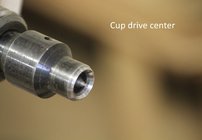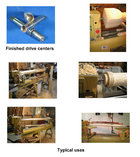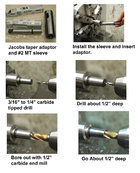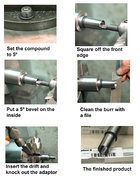Seems to be universally recommended to seat four prong spur drive centers by standing the spindle blank on a table directly over a leg, and with blows by a wooden mallet force the prongs into the end grain, about 1/16th". A StebCenter drive center is less aggressive, but sometimes is too quick to spin out. Can a StebCenter drive center also be seated with blows by a wooden mallet into the end of a spindle blank, without damaging the spring loaded center pin?
-
We just finished moving the forums to a new hosting server. It looks like everything is functioning correctly but if you find a problem please report it in the Forum Technical Support Forum (click here) or email us at forum_moderator AT aawforum.org. Thanks! -
Beware of Counterfeit Woodturning Tools (click here for details) -
Johnathan Silwones is starting a new AAW chapter, Southern Alleghenies Woodturners, in Johnstown, PA. (click here for details) -
Congratulations to Dave Roberts for "2 Hats" being selected as Turning of the Week for April 22, 2024 (click here for details) -
Welcome new registering member. Your username must be your real First and Last name (for example: John Doe). "Screen names" and "handles" are not allowed and your registration will be deleted if you don't use your real name. Also, do not use all caps nor all lower case.
You are using an out of date browser. It may not display this or other websites correctly.
You should upgrade or use an alternative browser.
You should upgrade or use an alternative browser.
Seating Drive Centers on Spindle Blanks
- Thread starter Don Stephan
- Start date
I've never had a problem with my Steb center engaging, even on harder woods. I just crank up the tail stock until the teeth on the Steb grab. On the very rare occasion when the wood stops spinning, I just crank the tailstock a little more until the Steb center re-engages.
In turning hundreds (thousands?) of spindles I have never driven a drive into the end of a spindle -- I wouldn't want to try with many of the longer ones I turn (e.g. 1x1x16). I don't use a spur drive -- either a steb or safety drive or hold the headstock end in a chuck (useful for stability with long/thin spindles). There is no need to hammer on a steb -- its teeth quickly engage. If it slips, you may be forcing your cut or need to sharpen your tool.
john lucas
AAW Forum Expert
I have not had a problem with the steb center. Are you sure your talistock is not the problem. That being said it won't hurt the steb center at all do drive it onto the wood as long as tou use a wooden malket.
- Joined
- Apr 27, 2004
- Messages
- 8,642
- Likes
- 4,982
- Location
- Lakeland, Florida
- Website
- www.hockenberywoodturning.com
Spur drives are ok.
For most all my spindles I use the ONEWAY cup center. This center cup matches my tail center.
I just put the point on center and tighten the tailstock.
Lots of advantages: quick, accurate, great for multi-center turnings, remounted pieces center perfectly,
A piece can be flipped end for end and center perfectly
In layouts the tailstock can be loosened and the piece rotated to line grain up with 0 on the index wheel

You can see how I use the cup center for a bal and a large spindle it theses tips threads.
 www.aawforum.org
www.aawforum.org
 www.aawforum.org
www.aawforum.org
For most all my spindles I use the ONEWAY cup center. This center cup matches my tail center.
I just put the point on center and tighten the tailstock.
Lots of advantages: quick, accurate, great for multi-center turnings, remounted pieces center perfectly,
A piece can be flipped end for end and center perfectly
In layouts the tailstock can be loosened and the piece rotated to line grain up with 0 on the index wheel

. A wooden mallet won’t hurt it but is unnecessary- can just tighten it.Can a StebCenter drive center also be seated with blows by a wooden mallet into the end of a spindle blank, without damaging the spring loaded center pin?
You can see how I use the cup center for a bal and a large spindle it theses tips threads.
Ball in a Ball
A ball in a ball is great fun. People try to figure out how? In the demo video I show how to turn a ball, hollow it to receive the smaller ball and then pop the smaller ball through the hole. There are also links to handouts I use in demos. dogwood large ball about 3” I got the idea for...
Suspended spherical forms
These forms have a hollow ball in the middle and wings or legs extending out on the sides. I hollow the ball held in a vacuum Chuck. I originated these forms in 2004 after contemplating making a two handled Soren Berger scoop. While I probably would not have gotten there without seeing...
Roger Wiegand
Beta Tester
I'm with Hockenbery on this. After significant frustration with splitting blanks with spur dives and sawing holes in others with the steb centers I've settled on a simple dead center type cup drive. No pounding, works extremely well to hold the work, easy to re-center pieces perfectly, plus the work just stops in the event of a bad catch avoiding further destruction. For large pieces Robust sells a larger diameter cup that screws on to the smaller cup center. I've driven bowl blanks 18" in diameter with that. Perhaps counterintuitively, the grip is much stronger than with the Steb-- more surface area in contact, perhaps.
I am with Roger and Al. I only use my Robust cup center. I have used spur and steb centers in the past, but the cup center drives fine and is much safer if you should get a catch.
Cup center = safety driver. I got indoctrinated with use of these in the two Derek Weidman classes I've taken. Absolutely essential for safe turning with his sort of turning.
john lucas
AAW Forum Expert
I guess I'm too aggressive. Cup centers in my headstock slip too easily. I like the steb center. Holds well but let's me reduce the pressure from the tailstock to reduce chatter.
I use the Steb center for all my work and it has never spun on me. It grips really well too.
Tom Gall
TOTW Team
Back in the day !!! (before Steb centers existed and I don't recall ever seeing a cup/safety center), I used to do a lot of spindle turning (bud vases) using exotic woods. Ever try hammering a spur center into end grain on Cocobolo? Almost impossible! So, after marking the centers and hammering a divot center point I would take it to the bandsaw. Stand behind the BS blade (teeth facing away) and pull the square into the blade to cut a kerf about 1/8" deep - flip 90º and repeat. Works great.Seems to be universally recommended to seat four prong spur drive centers by standing the spindle blank on a table directly over a leg, and with blows by a wooden mallet force the prongs into the end grain, about 1/16th". A StebCenter drive center is less aggressive, but sometimes is too quick to spin out. Can a StebCenter drive center also be seated with blows by a wooden mallet into the end of a spindle blank, without damaging the spring loaded center pin?
Tom:Back in the day !!! (before Steb centers existed and I don't recall ever seeing a cup/safety center), I used to do a lot of spindle turning (bud vases) using exotic woods. Ever try hammering a spur center into end grain on Cocobolo? Almost impossible! So, after marking the centers and hammering a divot center point I would take it to the bandsaw. Stand behind the BS blade (teeth facing away) and pull the square into the blade to cut a kerf about 1/8" deep - flip 90º and repeat. Works great.
That's the way l learned to do it as well - about 50-some odd years ago. No exotic woods though. I also remember doing the same thing with a backsaw, the idea being you cut a slot for the spur teeth to grab - no pounding necessary except to create the centre dimple which can be done with an awl in softer woods or a centre punch and "Yankee" drill in harder wood. Again little or no pounding necessary.
Cheers.
Barry W. Larson
Calgary, Alberta, Canada eh!
If you have a wooden V block you can do it from the front of the blade.Back in the day !!! (before Steb centers existed and I don't recall ever seeing a cup/safety center), I used to do a lot of spindle turning (bud vases) using exotic woods. Ever try hammering a spur center into end grain on Cocobolo? Almost impossible! So, after marking the centers and hammering a divot center point I would take it to the bandsaw. Stand behind the BS blade (teeth facing away) and pull the square into the blade to cut a kerf about 1/8" deep - flip 90º and repeat. Works great.
In the late 1990s I needed to turn some PT 6x6 posts. I called Myron Curtiss. He said to drive it with an Oliver dead center and don’t ask him why it works because he didn’t know. I knew the profile so I made one and sure enough it worked.
Later I did some experimenting with an import #2MT/33JT adaptor and came up with the below design and have been using it for the last 20 years. After reading an AAW article on Asian woodturning by Bonnie Klein, I realized this design was at least a century old.
Below is how to make one. The adaptor is hardened and ground so carbide is necessary. Oddly, some of the USA-made adaptors are mild steel and don’t give as durable of a rim.
I once tried the thing called a Stebcenter. One catch and it saws itself free. Glad I didn’t buy one. If that design had a tapered cylinder drive, it sure would do better. Maybe one day I’ll get one and turn off the circular saw teeth and see how that works.
How to make one if you know anyone with a metal lathe



Later I did some experimenting with an import #2MT/33JT adaptor and came up with the below design and have been using it for the last 20 years. After reading an AAW article on Asian woodturning by Bonnie Klein, I realized this design was at least a century old.
Below is how to make one. The adaptor is hardened and ground so carbide is necessary. Oddly, some of the USA-made adaptors are mild steel and don’t give as durable of a rim.
I once tried the thing called a Stebcenter. One catch and it saws itself free. Glad I didn’t buy one. If that design had a tapered cylinder drive, it sure would do better. Maybe one day I’ll get one and turn off the circular saw teeth and see how that works.
How to make one if you know anyone with a metal lathe



- Joined
- Apr 27, 2004
- Messages
- 8,642
- Likes
- 4,982
- Location
- Lakeland, Florida
- Website
- www.hockenberywoodturning.com
Nice tutorial. You should post this in the Tutorials and Tips. I deserves to stand on its own.In the late 1990s I needed to turn some PT 6x6 posts. I called Myron Curtiss. He said to drive it with an Oliver dead center and don’t ask him why it works because he didn’t know. I knew the profile so I made one and sure enough it worked.
Myron is a great guy and a wealth of knowledge. I got to spend an afternoon in his shop when I did a demo for his Club.
Quite a treat.
Tom Gall
TOTW Team
Exactly.Tom:
That's the way l learned to do it as well - about 50-some odd years ago. No exotic woods though. I also remember doing the same thing with a backsaw, the idea being you cut a slot for the spur teeth to grab - no pounding necessary except to create the centre dimple which can be done with an awl in softer woods or a centre punch and "Yankee" drill in harder wood. Again little or no pounding necessary.
Cheers.
Barry W. Larson
Calgary, Alberta, Canada eh!
Tom Gall
TOTW Team
True, especially if your turning "square" is actually square. And for accuracy you might want to use a fence for the V block. Many of my 2" square blanks were not truly square - so I would use the two sides that looked closest to 90º on the table when sawing the kerfs. That would give me the closest to maximum diameter for my product in those expensive woods ... and I just found it easier to do. BTW- back then I was paying $6 b.f. for Cocobolo - last I checked it was around $50+ b.f. Yikes!If you have a wooden V block you can do it from the front of the blade.
So many great comments and tips on the subject of safe drives. Thank you everyone.
